Royal
Westminster
Ophthalmic Hospital
178 High Holborn, WC1V 7AA
Ophthalmic Hospital
178 High Holborn, WC1V 7AA
Medical
dates:
Medical
character:
Specialist
The Royal Westminster Infirmary
for the Cure of Diseases of the Eye was founded at a meeting held in
the Thatched House Tavern on 5th December 1816 by George James
Guthrie, F.R.C.S. (1785-1856) for the "relief of necessitous
persons suffering from diseases of the eye". The Duke
of York was its Patron and the Duke
of Wellington its President. Guthrie had served
as an army surgeon during the Peninsular War
(1808-1814) with the Duke
of Wellington, and both had been shocked at the amount of eye
disease among the troops in the Peninsula. Both determined to
establish an eye hospital in London.
Until suitable premises could be found, clinics were established at Mr Guthrie's house at No. 2 Berkeley Street, Berkeley Square, on Monday, Wednesday and Friday mornings.
The Infirmary finally opened in a building in Marylebone Street, Piccadilly (now the eastern part of Glasshouse Street), later moving to Warwick Street in Golden Square. By 1825 some 10,000 patients, mainly the poor, had been treated.
The Infirmary had also become the chief ophthalmological teaching centre for officers of the Army Medical Service (the Charter of the Infirmary specifically allowed all members of the Army and Navy medical staff to practise there and to attend courses without charge).
After five years the Infirmary had outgrown its premises and land in King William Street, off West Strand, was found for a purpose-built hospital (it would share the island site with Charing Cross Hospital, also about to be built). In June 1831 the Duke of Richmond, one of the Hospital's Vice-Presidents, laid the foundation stone.
The new Hospital opened at No. 19 King William Street (later renamed William IV Street) in 1832. It was renamed the Royal Westminster Ophthalmic Hospital.
The building was reconstructed in 1900, 1906 and 1912. In 1910, when it had 40 beds, the Hospital received patients from Charing Cross Hospital, which had closed it Ophthalmic Department. The ever-increasing number of patients made working conditions too cramped and, as it was impossible to extend the building, it was decided to move to a new site with more space.
In 1926 a piece of land in Broad Street, Holborn, was purchased for £35,000 and the new Hospital opened in 1928. The 8-storey red brick building had cost £130,000 to build. From its roof, Hampstead, Blackheath and the Crystal Palace could be easily seen.
The Hospital had 82 beds, with the possibility of increasing the complement to 100. It was the second oldest and the second largest eye hospital in London (the first was Moorfields). The wards were light and airy, and there was an extensive suite of rooms for private patients (instead of cubicles or part of a ward sectioned off by canvas partitions). The Light Department provided treatment with ultraviolet light, diathermy and ionization. The Squint Department treated patients before and after operation with ocular exercises.
At the beginning of WW2 the Hospital had 100 beds, but the complement in use was reduced because of staffing shortages. In 1942 there were 54 beds in use but, by October 1943, the number had increased to 76. Patients who had suffered splinters or blast injuries to the eye during bombing raids were treated. A giant electro-magnet was used to remove metallic foreign bodies from the eyeball.
Following an aerial attack in June 1944, the Ministry of Health instructed that only urgent cases should be admitted, and this led to a decrease in the number of in-patients.
By 1944 the cost of maintaining the Hospital had increased by £3,213 to £26,307 (from £23,094 in 1943) - reflecting the rising prices of commodities, surgical equipment, staff salaries and wages, etc.
At the end of July 1945 the ophthalmic branch at Stanmore closed. It had been run during the war by Mr M.L. Hine, F.R.C.S., who had treated 1,026 patients sent from the parent hospital for treatment or surgery. The Hospital had also supplied the nurses.
The Hospital building had escaped serious damage to its structure during the war and, by 31st December 1945, had 80 beds in use (of which 16 - 14 beds and 2 cots - were in private patient rooms). New working regulations following the Rushcliffe Report had reduced working hours and increased 'off-duty' times for nurses, but this required the employment of more staff. However, because of the lack of accommodation in the Nurses' Home, new nurses could not be employed (even if they could be found), so the remaining 20 beds could not be re-opened. Larger premises were needed. During 1945 the annual running costs of the Hospital increased by £1,568 to £27,875.
While the Casualty Department remained open 24 hours a day, the Out-Patients Department was reconstructed at the end of 1946. The single large consulting room was replaced by three separate clinic rooms and six vision-testing compartments, all re-equipped with modern instruments. The whole exterior of the building was repainted, with plans to do the interior in 1947.
During 1946 it cost £35,795 to run the Hospital, including nurses' salaries and repairs to the building. The weekly cost of an in-patient was £7 2s 4d (£7.12), compared to £6 5d 8d (£6.28) in 1945. The average length of stay was 15 days.
A hospital survey, carried out by the Ministry of Health earlier in April 1945, had decided that there was no possibility for the Hospital to expand, except by acquiring adjoining land. However, if it amalgamated with another ophthalmic unit, this would create one large ophthalmic hospital. The decision to amalgamate was taken at a Special Meeting of the Board of Governors on 11th April 1946. On 1st January 1947 the Hospital officially merged with the Central London Ophthalmic Hospital in Judd Street and the Royal London Ophthalmic Hospital in Moorfields. It then became the Westminster Branch of the Moorfields, Westminster and Central Eye Hospital.
The Moorfields, Westminster and Central Eye Hospital joined the NHS in 1948 as a postgraduate teaching hospital.
The Westminster Branch closed in 1989.
Until suitable premises could be found, clinics were established at Mr Guthrie's house at No. 2 Berkeley Street, Berkeley Square, on Monday, Wednesday and Friday mornings.
The Infirmary finally opened in a building in Marylebone Street, Piccadilly (now the eastern part of Glasshouse Street), later moving to Warwick Street in Golden Square. By 1825 some 10,000 patients, mainly the poor, had been treated.
The Infirmary had also become the chief ophthalmological teaching centre for officers of the Army Medical Service (the Charter of the Infirmary specifically allowed all members of the Army and Navy medical staff to practise there and to attend courses without charge).
After five years the Infirmary had outgrown its premises and land in King William Street, off West Strand, was found for a purpose-built hospital (it would share the island site with Charing Cross Hospital, also about to be built). In June 1831 the Duke of Richmond, one of the Hospital's Vice-Presidents, laid the foundation stone.
The new Hospital opened at No. 19 King William Street (later renamed William IV Street) in 1832. It was renamed the Royal Westminster Ophthalmic Hospital.
The building was reconstructed in 1900, 1906 and 1912. In 1910, when it had 40 beds, the Hospital received patients from Charing Cross Hospital, which had closed it Ophthalmic Department. The ever-increasing number of patients made working conditions too cramped and, as it was impossible to extend the building, it was decided to move to a new site with more space.
In 1926 a piece of land in Broad Street, Holborn, was purchased for £35,000 and the new Hospital opened in 1928. The 8-storey red brick building had cost £130,000 to build. From its roof, Hampstead, Blackheath and the Crystal Palace could be easily seen.
The Hospital had 82 beds, with the possibility of increasing the complement to 100. It was the second oldest and the second largest eye hospital in London (the first was Moorfields). The wards were light and airy, and there was an extensive suite of rooms for private patients (instead of cubicles or part of a ward sectioned off by canvas partitions). The Light Department provided treatment with ultraviolet light, diathermy and ionization. The Squint Department treated patients before and after operation with ocular exercises.
At the beginning of WW2 the Hospital had 100 beds, but the complement in use was reduced because of staffing shortages. In 1942 there were 54 beds in use but, by October 1943, the number had increased to 76. Patients who had suffered splinters or blast injuries to the eye during bombing raids were treated. A giant electro-magnet was used to remove metallic foreign bodies from the eyeball.
Following an aerial attack in June 1944, the Ministry of Health instructed that only urgent cases should be admitted, and this led to a decrease in the number of in-patients.
By 1944 the cost of maintaining the Hospital had increased by £3,213 to £26,307 (from £23,094 in 1943) - reflecting the rising prices of commodities, surgical equipment, staff salaries and wages, etc.
At the end of July 1945 the ophthalmic branch at Stanmore closed. It had been run during the war by Mr M.L. Hine, F.R.C.S., who had treated 1,026 patients sent from the parent hospital for treatment or surgery. The Hospital had also supplied the nurses.
The Hospital building had escaped serious damage to its structure during the war and, by 31st December 1945, had 80 beds in use (of which 16 - 14 beds and 2 cots - were in private patient rooms). New working regulations following the Rushcliffe Report had reduced working hours and increased 'off-duty' times for nurses, but this required the employment of more staff. However, because of the lack of accommodation in the Nurses' Home, new nurses could not be employed (even if they could be found), so the remaining 20 beds could not be re-opened. Larger premises were needed. During 1945 the annual running costs of the Hospital increased by £1,568 to £27,875.
While the Casualty Department remained open 24 hours a day, the Out-Patients Department was reconstructed at the end of 1946. The single large consulting room was replaced by three separate clinic rooms and six vision-testing compartments, all re-equipped with modern instruments. The whole exterior of the building was repainted, with plans to do the interior in 1947.
During 1946 it cost £35,795 to run the Hospital, including nurses' salaries and repairs to the building. The weekly cost of an in-patient was £7 2s 4d (£7.12), compared to £6 5d 8d (£6.28) in 1945. The average length of stay was 15 days.
A hospital survey, carried out by the Ministry of Health earlier in April 1945, had decided that there was no possibility for the Hospital to expand, except by acquiring adjoining land. However, if it amalgamated with another ophthalmic unit, this would create one large ophthalmic hospital. The decision to amalgamate was taken at a Special Meeting of the Board of Governors on 11th April 1946. On 1st January 1947 the Hospital officially merged with the Central London Ophthalmic Hospital in Judd Street and the Royal London Ophthalmic Hospital in Moorfields. It then became the Westminster Branch of the Moorfields, Westminster and Central Eye Hospital.
The Moorfields, Westminster and Central Eye Hospital joined the NHS in 1948 as a postgraduate teaching hospital.
The Westminster Branch closed in 1989.
Present status (November 2008)
The first purpose-built Hospital in King William Street (William IV Street) was taken over by Charing Cross Hospital when it was vacated in 1928.
The second Hospital building in High Holborn was demolished. Its site is now occupied by the High Holborn Residence, a 13-storey residential block for students at the London School of Economics, which opened in 1995.
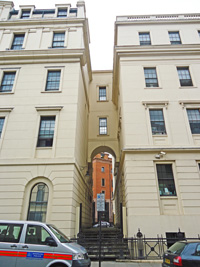
The first site of the Hospital in William IV Street later became part of Charing Cross Hospital. The building (on the left) is connected at the upper levels by a bridge to the former Charing Cross Hospital (on the right).
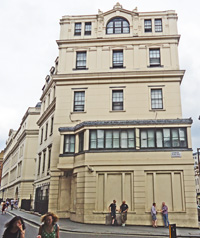
The original foundation stone for the Royal Westminster Ophthalmic Hospital (below) remains at the base of the west corner of the former Charing Cross Hospital (now the Charing Cross Police Station) in Chandos Place (above).
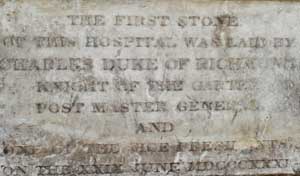
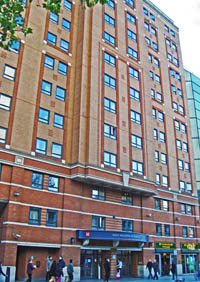
The site of the second and final Hospital building is now the High Holborn Residence (above and below).
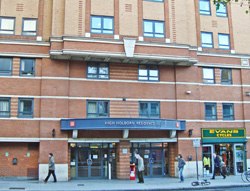
(Author unstated) 1928 Rebuilding of the Royal Westminster Ophthalmic Hospital. British Journal of Ophthalmology 12, 322-323.
(Author unstated) 1930 Untitled. British Medical Journal 1 (3603), 164.
Caddy A 1931 The Royal Westminster Ophthalmic Hospital and its staff in the past. British Journal of Ophthalmology 15, 498-511.
Grimsdale H 1919 British Masters of Ophthalmology Series. 9 - George James Guthrie, F.R.S. (1785-1856) Founder of the Royal Westminster Ophthalmic Hospital. British Journal of Ophthalmology 3, 144-152.
http://hansard.millbanksystems.com
www.aim25.ac.uk
Return to home page